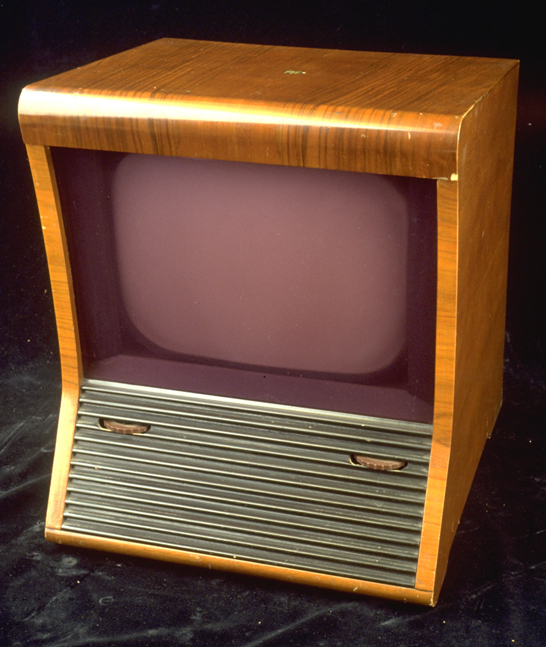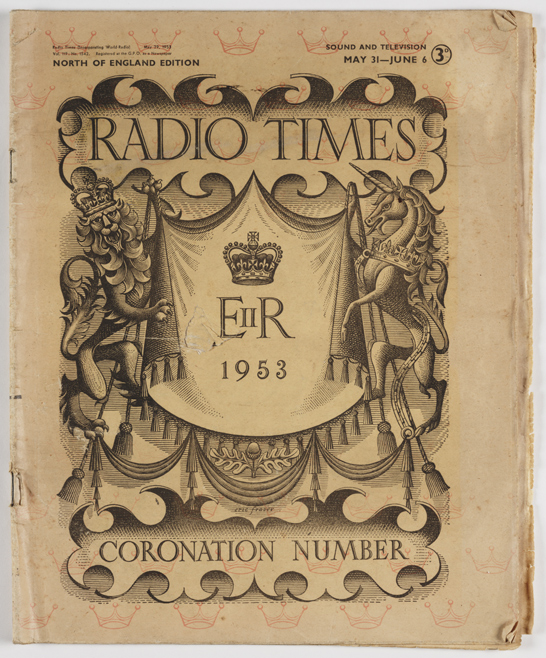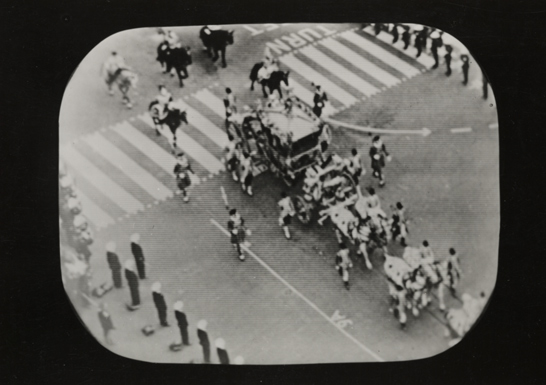Many of our significant television-related acquisitions relate to one very important event in the history of television. Queen Elizabeth II’s Coronation on June 2, 1953 put television on the map. Today we celebrate the 60th anniversary of that momentous day by sharing some key objects from our archives.
The BBC prepares…
In the days leading up to the Coronation, cameras were set up all over London. It promised to be the BBC’s biggest ever outside broadcast at the time. Our collection highlights some of the technical achievements and breakthroughs made for the day.
A good example of such an object is the Watson zoom lens. Three cameras with zoom lenses like this one were used on the Thames Embankment to capture the outgoing procession as well as the fireworks display.

The national television network expands
An urgent post-war task was to spread coverage of television throughout the country. Four new high-power transmitters at Sutton Coldfield (Midlands), Holme Moss (Northern England), Kirk O’Shotts (South Scotland) and Wenvoe (South Wales) were completed by 1952, bringing 81% of the population within range.
With signals now available, people went out in their thousands to buy their first television sets in time to see the Coronation.

Watching the Coronation
Introduced by Sylvia Peters, the Coronation of Queen Elizabeth II would represent for many British people the first time they watched television. It was also the first time television had brought the nation together in such as shared experience.
The ceremony was viewed by an estimate 20 million people huddled around small television sets in their homes. It was calculated each set in Britain was watched by an average of 9 people.

Recognising the Coronation today
The collecting of items relating to the Queen’s Coronation in 1953 continues today. For example, recently we acquired a set of ten Tele-Snaps, photographs taken from television screens using a special technique by the photographer John Cura.
Unlike films of the Coronation, this series of Cura’s Tele-Snaps provide us with a crucial record of the Coronation as it actually appeared to the television audience in 1953. These likely resemble the selection of Cura’s Coronation Tele-Snaps which were mounted in a commemorative album and later presented to Her Majesty by the BBC.

Thanks, Iain, for this very informative post.
Here in Canada, our local cable company is showing the entire Coronation as it appeared on BBC including the processions to and from Westminster Abbey;7 hours of programming without any commercial breaks. It is uncanny experience to watch this after so many years — a time trip worthy of Dr.Who.
The BBC Television Service, in its infinite wisdom wanted its viewers to watch the Coronation with the best possible picture quality, so Test Card C was radiated from 9.15 until 10.15 to enable viewers at home, etc to adjust contrast, brightness, fine tuning, etc to the best possible quality.
The lunch period on the day was marked by all the presenters going away from the camera presumably to a canteen. The camera was then pointed at a flag for an hour with only ambient sound from the street. After lunch, they returned and continued. Today the time would be filled with vacuous celebrity interviews explaining how they ‘reacted’, event summaries and ‘key moment’ replays.
The entire coronation ceremony was interminably long, and sad to say, to our eyes now, very dull and tedious. have watched it twice since in 1977 and 2013 with the official Coronation Service Book and music scores in front of me. The copy I have once belonged to Lady Isobel Barnet. The next one will no doubt be done very differently. I watched it at the time aged 4 from under a trolley laden with sandwiches (crusts removed) in Carshalton Beeches.
I can’t remember much of the 1953 coronation being a 5 year old toddler at the time but I can remember my grandmother and uncle having newly bought TV sets as Pontop Pike began transmission in the North East, I believe, one month before the event and strange ‘H’ structures appearing on their houses.